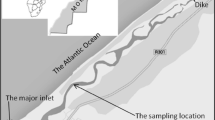Abstract
The sediment cores from Tokyo Bay and Funka Bay were analyzed for U and its isotopic ratio,234U/238U, after dissolving them in 0.1 M HCl, and 30% H2O2 in 0.05 M HCl. A small fraction of U in the anoxic sediments was dissolved in 0.1M HCl and even the added yield tracer,232U, was lost. The isotopic ratio of H2O2 soluble U in the sediments was equal to that of seawater, suggesting that the H2O2 soluble U in the sediments is authigenic. The 6M HCl solution dissolved part of the lithogenic U besides the authigenic U. The depth profiles of U from the two bays resembled each other. The authigenic U comprised more than half of the total U even at the surface and increased with depth down to 70 cm, showing small maxima at about 20 cm. The concentration of refractory U was nearly constant with depth and similar to that of the pelagic sediments. The highest U concentration, 6 µg g−1 which was about 5 times that of the pelagic sediments, was observed in the layer between 70 and 160 cm depth in Tokyo Bay. The annual sedimentation rates of U in the Tokyo Bay sediments were 2.6 tons at the surface and 7.0 tons at the 70–160 cm depth. The increase in U with depth should be due to the deposition of interstitial U either diffusing downward from the surface indicating the trapping of seawater U, or otherwise diffusing upward from the deeper layer indicating the internal cycling of U within the sediments.
Similar content being viewed by others
References
Anderson, R.F., A.P. LeHuray, M.Q. Fleisher and J.W. Murray (1989): Uranium deposition in Sannich Inlet sediments, Vancouver Island. Geochim. Cosmochim. Acta,53, 2205–2213.
Borole, D.V., S. Krishnaswami and B.L.K. Somayajule (1982): Uranium isotopes in rivers, esturies and adjacent coastal sediments of western India: their weathering, transport and oceanic budget. Geochim. Cosmochim. Acta,46, 125–137.
Burton, J.D. (1975): Radioactive nuclides in the marine environment. p. 91–191.In: Chemical Oceanography, 2nd ed., Vol. 3, ed. by J.P. Riley and G. Skirrow, Academic Press, London.
Cochran, J.K., A.E. Carey, E.R. Sholkovitz and L.D. Surprenant (1986): The geochemistry of uranium and thorium in coastal marine sediments and sediment pore waters. Geochim. Cosmochim. Acta,50, 1663–1680.
Garrels, R.M. and C.L. Christ (1965): Solutions, minerals, and equilibria. Harper & Row, New York, 450 pp.
Goldberg, E.D. and G.O.S. Arrhenius (1958): Chemistry of Pacific pelagic sediments. Geochim. Cosmochim. Acta,13, 153–212.
Goldberg, E.D., W.S. Broecker, M.G. Gross and K.K. Turekian (1971): Marine chemistry. p. 137–146.In: Radioactivity in the Marine Environment, National Academy of Sciences, Washington, D.C..
Hattori, A. (ed.) (1981): Distributions and fate of pollutants in coastal environments—Data records 1979–1980. B-97-R14-4 (Environmental Science, Ministry of Education), 87 pp.
Hattori, A. (ed.) (1982): Distributions and fate of pollutants in coastal environments and dissolution of chemical substances from the shallow sea bottom—Data records supplement. B-141-R14-1&4.
Heye, D. (1969): Uranium, thorium, and radium in ocean water and deep-sea sediments. Earth Planet. Sci. Lett.,6, 112–116.
Ku, T.-L. (1965): An evaluation of the234U/238U method as a tool for dating pelagic sediments. J. Geophys. Res.,70, 3457–3474.
Kuroda, P.K. (1982): The origin of the chemical elements and the Oklo Phenomenon. Springer-Verlag, Berling, 165 pp.
Matsumoto, E. (1983): The sedimentation environment in the Tokyo Bay. Chikyukagaku (Geochemistry).17, 27–32.
Matsumoto, E. and S. Togashi (1980): Sedimentation rates in Funka Bay, Hokkaido. J. Oceanogr. Soc. Japan,35, 261–267.
Nagao, S. and S. Tsunogai (1990): Uranium in pore water from Funka Bay sediments. Submitted to Geochem. J..
Tsunogai, S. and S. Noriki (1983): Chemical oceanography: how to solve the ocean by chemistry. Sangyo Tosho, Tokyo, 286 pp.
Veeh, H.H. (1967): Deposition of uranium from the ocean. Earth Planet. Sci. Lett.,3, 145–150.
Yamada, M. and S. Tsunogai (1984): Postdepositional enrichment of uranium in sediment from the Bering Sea. Mar. Geol.,54, 263–276.
Yamada, M., H. Kitaoka and S. Tsunogai (1983): A radiochemical sedimentation onto the Japan Trench floor. Deep-Sea Res.,30, 1147–1156.
Author information
Authors and Affiliations
Rights and permissions
About this article
Cite this article
Tsunogai, S., Nagao, S., Watanabe, S. et al. Uranium in coastal sediments of Tokyo Bay and Funka Bay. Journal of the Oceanographical Society of Japan 46, 211–218 (1990). https://doi.org/10.1007/BF02124908
Received:
Revised:
Accepted:
Issue Date:
DOI: https://doi.org/10.1007/BF02124908




